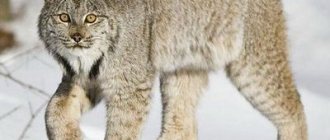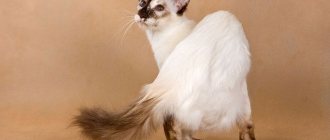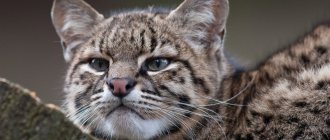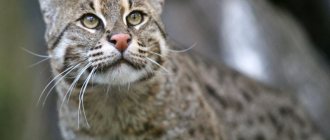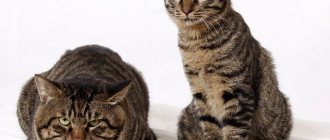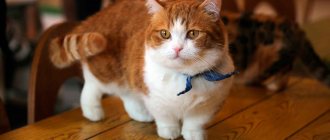What will you learn from the article?
- Origin story
- Appearance of a jungle cat
- Character
- Is it possible to keep a jungle cat at home?
- Health
- Caring for a jungle cat
- Feeding
- Where to buy a reed kitten?
Some become fans of the TV series House, while others enjoy the charm of the jungle cat, which is also called... yes, that's right - house. So, meet the jungle cat, aka house, aka swamp lynx or, scientifically, Felis chaus!
The jungle cat is a true predator that once lived in 25 countries. Nowadays, he lives only in zoos or in the apartments of his fans.
Origin of the swamp cat and domestication
This feline species was first described in scientific literature in the mid-18th century. The first cases of domestication of the jungle cat date back to Ancient Egypt. This animal reacted quite calmly to living next to a person. The images found suggest that the ancient race often used the Hausa to hunt hares.
In its natural habitats, this predator is very careful and silent, trying not to contact people for whom it does not pose a danger. But during rutting periods it is better not to meet with him. At this time the animal is quite aggressive.
This is a nocturnal animal that loves to hunt small rodents and birds, preferring especially overgrown areas for this. When living in an apartment or house, they retain their habits - they prefer to sleep during the day and show signs of activity at night.
Photo gallery of the jungle cat:
History of the breed
Felis chaus is an ancient breed that the Egyptians were the first to try to domesticate about 3 thousand years ago. Back then, hunters used the Nile cat to hunt waterfowl. Egyptian scrolls depict swimming animals that bring game to humans. In ancient times, the breed lived in at least 25 countries, but everywhere the animal had a reputation as a dangerous, wild predator, which people tried to avoid.
The beast was a serious problem for the population of the villages, as it hunted pheasants and muskrats. After the onset of cold weather, the predator moved closer to people’s houses and attacked poultry. Hunters caught wild cats to use their skins for farming. The jungle cat is not a domestic animal, but a predator living in the wild. In the 18th century, breeders were able to develop a special breed - the “house”, which is a hybrid of the reed lynx with an ordinary cat.
In the 20th century, sociable, friendly “Houseies” appeared in the United States, which were born by crossing wild jungle cats with short-haired domestic cats. This is how the Jungle Curl, Stone Cougar, and Chausi (Housey) breeds appeared, keeping them at home is safer and more legal. Breeders were able to develop breeds that retained the external beauty, large size and disposition of a wild nocturnal animal, combined with the docility of a domestic pet.
Subspecies of the jungle cat
The jungle cat has ten subspecies living in the wild in Asia, China, Indochina and Indonesia, Transcaucasia, Dagestan, Stavropol and North Ossetia.
Caucasian jungle cat (Felis chaus chaus)
Described by Schreber in 1777, this main subspecies is found in Russia (in the northwest of the Caspian Sea within the Astrakhan region, Kalmykia of Dagestan, Chechnya, Ingushetia and North Ossetia), Azerbaijan, Armenia, Georgia, Turkmenistan, Iran, Iraq, Syria, some parts of Turkey.
Turkestan jungle cat (Felis chaus oxiana)
You can meet the cat in Central Asia, apparently in northern Afghanistan. The coloring of the subspecies is lighter than that of the previous Caucasian one.
Felis chaus affinis
Gray described cats in 1830. This subspecies lives in the Himalayas (from Kashmir and Nepal to Sikkim and Yunnan). It differs from the well-known typical Caucasian reed cat in that its fur is not so long and rich, and its skull and teeth are smaller.
Felis chaus fulvidina
The subspecies was characterized by the scientist Thomas in 1929. It lives in southeast Asia, its exact distribution is unknown.
Felis chaus furax
This predator can be found in Palestine, Israel, Jordan, and Lebanon. Also in Turkey and southwest Syria. This cat has larger teeth than our Caucasian jungle cat.
Felis chaus kelaarti
Distributed throughout Sri Lanka and southern India.
Felis chaus kutas
It lives in the north and center of India, as well as in northern Pakistan.
Felis chaus maimanah
Distributed in northwestern Afghanistan.
Felis chaus nilotica
It lives in Egypt, mainly along the Nile. It is distinguished by a generally darker color than, for example, the furax subspecies.
Felis chaus prateri
Lives in Pakistan and a small part of western India.
Lifestyle of the swamp lynx
The swamp lynx lives in dense lowland forests near rivers and lakes. The cat makes a shelter in the depths of reed thickets, often right on the ground, lining the rookery with wool and dry plant stems. Sometimes it spends the night in the burrows of other animals, but never digs the ground itself. The swamp lynx avoids open places, prefers to move along different paths and easily makes its way through thickets of thorny bushes. The house endures cold winters with difficulty, since it is a heat-loving animal.
The animal leads a solitary lifestyle, with the exception of the mating season: during the breeding season, the cat takes on a partner. The female and male live and take care of the growing offspring together, dividing the prey among everyone. The house hunts on an area from 45 to 180 square meters. km., depending on the region of residence. The male's territory overlaps with the habitats of several females. The reed cat is an excellent swimmer and diver, but does not like to climb trees.
- 4 main dangers facing single pensioners
- How to overcome laziness in 7 steps
- 8 ways to save on taxis
Description of the animal
House is a medium-sized cat, but much larger than any domestic cat. Its distinctive features include:
- Slender and muscular, not too long, the body of an athlete, reaching one meter together with the tail in especially large specimens.
- The tail is significantly shorter than that of most cat species (up to 30 cm).
- The paws are long, slender and muscular, ending in large pads with powerful claws.
- High-set, medium-sized ears may have small tufts.
- Like all wild cat species, the Hausa has light spots on the back surfaces of its ears - false “eyes”. It is along them that the brood, following its mother at dusk, orients itself.
- The color of the short, dense coat is ticked - from yellowish-gray to brick-brown with noticeable gray hair.
- The muzzle is large, heavy, slightly elongated, with an elongated nose ending in a convex brick-colored lobe.
- The eyes can be topaz or emerald shades, depending on the shade of the coat.
- Large individuals weigh a little more than twenty kilograms. Domesticated ones are usually smaller than their wild relatives.
- In captivity they can live more than fifteen years, wild individuals live a little less.
This strong, large and heavy animal for a domestic cat is very graceful and agile.
Four-legged hunters
The wild jungle cat lives on almost all continents of the Earth. These mustaches are found in the lower reaches of the Nile, as well as in Turkey, India, Central Asia and even on the Volga, Caucasus and coastal areas of the Caspian Sea.
There are 9 registered subspecies of the jungle cat. Wild representatives are very similar in appearance to lynx, but much smaller in size. Most often the color is gray.
Mr. Cat recommends: features
In nature, the house lives in thickets of bushes and reeds growing along the banks of water bodies; it is an excellent swimmer and fisherman. These are due to his love for water and at home.
In addition, water procedures allow them to keep their thick fur in order; House does not emit a specific cat smell, unlike other representatives of domestic cat breeds. Therefore, it is worth taking care of organizing a place for the animal to bathe.
This is a very devoted and faithful creature, but he will not sit on his lap if he does not want to. It is worth considering the peculiarity of this type of cat and not keeping it in families with small children. They will unnecessarily irritate the pet with their increased attention, and he, in turn, can cause injury to them (do not forget about his size and wild past).
At the same time, the animal feels absolutely comfortable in the vicinity of dogs, provided that they also do not show particular persistence in communicating with him. If the family has birds or rodents, you should take care of their safety, as the house will hunt them.
Thanks to their fairly high intelligence and memory, these large cats easily open doors and remember where the things that interest them are. Due to their flexibility and developed muscles, they often use furniture as sports equipment, while climbing to the very top. So it is useless to hide objects from them on cabinets and shelves - they will climb into them with ease and even pleasure.
This is a very kind and obedient animal, requiring, like other representatives of cats, care, attention, affection and care.
Tolerance for children
Despite the fact that you won’t get bored with Houses, this behavior makes this breed unsuitable for families with small children: if, while playing, a cat weighing ten to fifteen kilograms jumps on the baby, injuries cannot be avoided. You cannot explain to an animal that a human baby is poorly adapted to active entertainment. So it’s better to get Houses when children reach adolescence: in this case, they will become ideal companions for fun romp. A swamp cat is also not suitable for older people, especially lonely ones, since they are no longer able to pay much attention to the pet, much less play with it, and this has a bad effect on its mood and well-being.
Personality of the pet
Natural species of Hausa have a reserved and cautious character. These nocturnal hunters are extremely silent, changing their habits only during the mating period, which occurs at the end of winter and beginning of spring. The domesticated jungle cat, while maintaining the inherent caution of the species, is able to show curiosity and sociability, and be a playful and active pet. More often than not, House chooses one owner for himself, and his devotion is truly dog-like. But he also treats other household members with patience and kindness.
Currently, a mixture of the swamp lynx with the Abyssinian cat breed is very popular. Such animals are called Chausie. They look exactly like their wild relatives, but differ from them in their kind and affectionate character.
Chausie cat
It is worth consulting with your veterinarian about the possibility of spaying or neutering. If there are no plans to breed this type of cat, it is better to carry out such an operation, this will not only increase the life expectancy of the pet, but will also get rid of territory marks around the apartment, which will protect against unpleasant odors.
It is imperative to purchase a scratching post and a large litter tray for the animal; a regular cat litter box will not work. Also give them a bath periodically, as they love to bathe.
Care and care
The diet of jungle cats is quite specific. Ready-made dry food is absolutely not suitable for them - raw meat is required. From time to time, it is advisable to give live food - mice, rats (of course, not in front of children.) Once a week, to prevent obesity, you need to arrange a day of fasting: when kept at home, swamp cats spend much less energy than in the wild. To maintain good shape, they need ultraviolet light: in their natural environment, marsh lynxes often bask in the sun.
Health
Such a cat has excellent health and immunity, since its genes were selected by nature itself. They are completely free of any hereditary diseases that are typical for artificially bred, “refined” cat breeds.
There are no special problems when keeping an animal. But he needs ultraviolet light, and therefore it is recommended to walk such pets outside on a harness, as well as a balanced diet. The jungle cat requires the attention and affection of the owner and games.
If these simple rules are followed, the animal will delight its owners with many years of life. Typically, the life expectancy of a jungle cat is 13-18 years. Also read the article about how long cats live.
How to choose a kitten
It is better to buy a baby cane cat at the age of 3 months - this is the optimal age for taming and starting to train the animal. It is also at this time that the difference between a House cat and a normal kitten born in the same litter becomes apparent. At 3 months, the animal should already have all its vaccinations. When choosing a kitten, pay attention to the following aspects:
- availability of the necessary set of documents certifying the breed and pedigree of the animal;
- the kitten's disposition should be cheerful, playful, affectionate;
- the baby must be accustomed to go to the tray and use a scratching post;
- Ideally, the animal should treat other kittens and strangers well and calmly.
Where can I buy
Buying a kitten is not easy, since only a few nurseries breed and sell House cats. An alternative to finding a specialized cattery is to buy a jungle cat at an exhibition of elite breeds. It is important that the animal has all the documents and vaccinations, but even with this there is no guarantee that the pet will grow up friendly and obedient. In Russia, the breed is bred in the following institutions:
- Ascheracat (Moscow);
- Lunicorn (Moscow region);
- Benabi (Saratov).
How much does a jungle cat cost?
It is difficult to purchase a representative of the breed not only because of the small number, but also the high price. Private nurseries breed and sell kittens. In addition to them, there are companies that sell wild cats and other exotic animals. In Russia, the price of a Hausa kitten ranges from 100-150 thousand rubles. If you find a cheaper option, there is a risk that they are trying to sell you ordinary kittens of a similar color.
What care does a jungle cat need?
Representatives of this species easily get used to humans, but it is worth considering that an adult specimen cannot be domesticated. It is worth purchasing a kitten up to 7-8 months old from a special nursery that breeds this species. If taken at an older age, the animal has difficulty getting used to new owners.
He will feel most comfortable in a house where there is an opportunity to run around in the surrounding area, but he will also be comfortable in an apartment, provided he takes frequent walks. Be sure to arrange regular water treatments. Ideally, he should have a swimming pool and an aviary in front of the house for independent walking.
The Hausa has strong hunter instincts, so it is necessary to periodically organize a “hunt” for live prey. For example, rodents or fish. This will help keep the animal in good shape and prevent it from getting bored.
Gaming potential
The complex nature of this cat predetermines the system of relationships with its owners. Houses are active, tireless, and inquisitive. Keeping them requires a lot of space, and an apartment is not suitable for this: you need a plot, preferably with a pond, so that the animal can swim at any time and satisfy the need for movement. And they move a lot, including at night. The owners are considered play partners and are happy to involve them in their fun, which is very noisy and energetic. Hausas especially enjoy jumping from ambushes.
Nutrition
Representatives of this species feed on a variety of foods: small rodents, fish, crustaceans, small birds, etc. If such a cat settles close to human habitation, for example, a village, it can steal poultry.
It begins hunting in the late afternoon and at night, tracking down the intended prey with extreme caution, silently creeping up to it.
The “fishing” of such an animal is very interesting: it lures fish with light blows of its paws on the water, imitating the movement of insects. The prey that swims up to this trick is caught with long sharp claws or dives into the water after it.
It doesn’t mind eating lizards and frogs; it can also eat a snake, easily dealing with it. When feeding at home, you should pay close attention to its preferences and habits in the wild.
Where does it live?
Swamp lynx, house, jungle or Nile cat - all these are names for one representative of the cat family that lives in tugai forests and dense reeds. Representatives of the breed lead a solitary lifestyle, do not like open areas, but sometimes make forays and come to desert places with lumpy sands. However, the animal does not go far from its habitat. In winter and spring, the predator enters settlements to hunt poultry. In mountainous areas, the house does not rise above 100 m, since heat-loving cats do not like frost and snow.
Houses are attracted to the banks of ponds with lush vegetation, where they can hunt ducks and other animals. Cats make shelters in thickets of reeds or intertwined bushes. At the same time, the animal does not make holes, preferring to occupy ready-made abandoned dwellings of foxes or badgers. Marsh lynxes do not stay in one place for a long time, periodically changing shelters. Cats often approach the coastal strip, leaving tracks on muddy areas and shallows.
Cats swim well, dive for fish, and dive into water to eliminate their own smell. The latter distinguishes the jungle cat from the domestic breed, which tends to leave odorous traces everywhere (this is how the animal marks its territory). Wild cats live in the territory:
- Kazakhstan;
- low-lying banks of the Nile and Volga;
- Indochina;
- Iran;
- Dagestan;
- Eastern Turkey;
- India;
- Palestine;
- Caucasian forests;
- river openings of Central Asia.
Appearance Features
Pets of this species have a dangerous temperament, and felinologists even warn against possible difficulties. But first, let's give a description of the jungle cat breed.
Weight reaches 12-15 kg. The cats are large at the withers, up to half a meter. The tail is relatively short, very thin, no more than 35 cm long. The head is not very large, rounded. The ears are large and have tufts inside.
The eyes are almond-shaped, regular in shape. The claws are very massive and sharp. The color is varied, from gray to dark brown with shades of red.
The pattern is interesting: blurry spots, stripes. The fur is quite thick and dense.
In the photo, jungle cats seem docile and very peaceful, but these beauties can literally turn a house upside down.
Pros and cons of the breed
It is advisable to purchase houses for the following reasons:
- they have a rather beautiful, unusual, graceful appearance;
- strong, resilient;
- active, love to play and interact with people;
- quickly get accustomed to the potty and scratching post;
- good hunters;
- friendly, gets along with other animals;
- become attached to the owner.
The disadvantages include the following:
- pets are quite large, so they require a lot of food;
- cats need to be walked;
- because of this, they must be frequently treated for fleas and helminths;
- You can feed only high-quality food.
